Ever thought about turning that neglected backyard into a zen paradise?
Creating my serene meditation garden was a journey I didn’t know I needed.
I mean, who knew bamboo and stone could become my best friends?
I rolled out some plush mats for comfort (because who wants to sit on the cold ground, right?) and chose soft greens and blues that soothe the soul.
Adding lavender and jasmine—let’s just say my senses have never been happier.
Water features? Total game changer. The gentle trickle might just drown out my neighbor’s chainsaw symphony.
So, ready to dive into tranquility?
Designing a Zen Sanctuary: My Meditative Escape
One day, after a chaotic week, I decided to tackle my overgrown yard. Armed with pruners, I transformed it into a lush oasis. I found some forgotten stone sculptures and arranged them with symmetry in mind—it was like playing a real-life Tetris! I later added a tiny pond; the sound of water is so therapeutic. Turns out, nature’s whispers are way better than scrolling through social media. It became my daily escape, reminding me to breathe and just be. Gardening isn’t just digging; it’s a journey toward peace.
Quick Takeaways
- Designate a meditation corner with natural materials like stone and bamboo, using soft mats for ultimate comfort and tranquility.
- Incorporate aromatic plants, such as lavender and rosemary, to create a calming fragrance that enhances the peaceful atmosphere.
- Add water features like fountains or koi ponds to introduce soothing sounds and visual elements that promote relaxation.
- Utilize a Japanese Zen garden layout with raked gravel, boulders, and selected plants to foster mindfulness and harmony.
- Collaborate with local horticulturists to choose sustainable plants and design accessories that resonate with the surrounding environment.
Designate a Meditation Corner or Space

When you consider how to create your own tranquil oasis, one of the most essential steps is to designate a meditation corner or space that reflects peace and serenity.
I’ve found that choosing natural materials, like stone or bamboo, fosters harmony. You can enhance your nook with a soft, inviting mat, perhaps from brands like Manduka or Jade Yoga.
Incorporate elements like lanterns or water features for soothing sounds. Color matters too; gentle greens and soft blues evoke calmness.
Just like famed gardener Gertrude Jekyll emphasized beauty in gardens, I believe your space should inspire liberation and serenity.
That’s why I created Botanical Mood to celebrate such designs. Additionally, incorporating zen elements such as rocks and plants can further promote a sense of mindfulness and tranquility in your meditation area.
Incorporate a Scented Garden

A beautifully curated scented garden can transform your meditation area into an immersive sensory experience.
I love incorporating aromatic plants like lavender, rosemary, and jasmine—they not only uplift the spirit but are also known for their calming properties. Choosing fragrant flowers, such as roses or peonies, adds vibrant color and sweet scents that soothe the soul. Including decorative garden border plants can enhance the overall aesthetic and create a cozy atmosphere.
Inspired by renowned gardeners like Monty Don, I recommend arranging your plants in layers, creating dimension and privacy.
As I designed this website, Botanical Mood, I aimed to share the liberating beauty of gardens, inviting you to cultivate your own peaceful sanctuary full of enchanting fragrances.
Create a Moon Garden

Creating a moon garden can be a magical addition to your outdoor space, especially during the enchanting hours of twilight and beyond.
I’ve found that incorporating white and silver blooms, like moonflowers and silver mound artemisia, creates a serene glow.
Consider using soft lighting, such as lanterns, to enhance the calming ambiance.
The designs of renowned gardeners, like Gertrude Jekyll, inspire my choices, making me appreciate the interplay of light and shadow.
Pairing soft textures and soothing colors, I aim to invite peace and reflection in the garden.
I hope my journey inspires freedom and tranquility in your own moon garden.
Add a Water Feature

Incorporating a water feature into your garden not only enhances its serene atmosphere, but also invites a symphony of soothing sounds that can transform your outdoor space into a tranquil retreat.
Personally, I’ve found that even a small fountain can provide immense peace.
- Consider a koi pond for vibrant life and gentle splashes.
- A simple bubbling rock can offer a natural touch while saving space.
- A small waterfall brings visual drama, creating a mesmerizing flow like those renowned designer vistas by Monet.
Adopt a Japanese Zen Garden Layout

One couldn’t help but admire the timeless elegance of a Japanese Zen garden layout, which offers a unique approach to serenity and simplicity that resonates deeply with many gardeners.
Incorporating elements like raked gravel to symbolize water, boulders representing mountains, and a few carefully placed plants can create a peaceful atmosphere.
As renowned gardener Shunmyo Masuno illustrates, balance is key.
I created this website, Botanical Mood, to inspire others to find liberation through such mindful designs.
Embracing these principles not only nurtures your spirit but transforms your garden into a sanctuary of tranquility and reflection.
Use Natural Materials
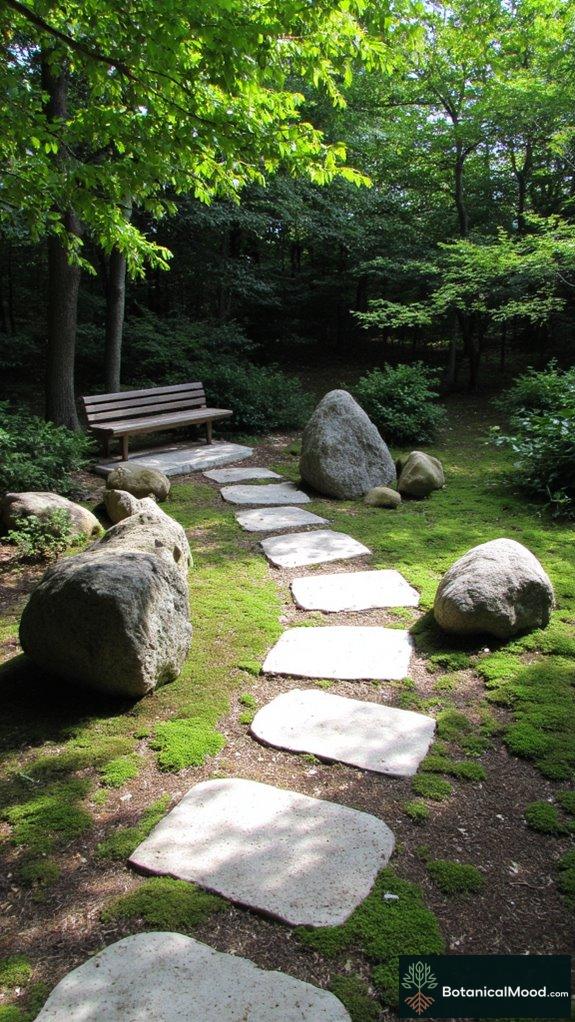
Natural materials are the heart and soul of a serene meditation garden, as they effortlessly blend with the environment and enhance the sense of tranquility.
By using elements from nature, I create a space that feels harmonious and inviting.
Consider these natural materials:
- Stone pathways: They guide the eye and feet, bringing a sense of permanence.
- Wooden benches: Perfect for reflective sitting, fostering relaxation amidst greenery.
- Natural boulders: They can serve as focal points, giving your garden a unique character.
In my journey through attracting serenity, I learned the importance of these materials and their liberating effects.
Choose a Soothing Color Palette

Creating a calming atmosphere in your meditation garden goes beyond selecting the right materials; it also involves the thoughtful choice of colors.
I love to incorporate soft blues, gentle greens, and neutral tones that evoke tranquility and harmony. Shades like lavender and creamy whites can enhance the serene vibe, much like the designs of renowned gardeners such as Piet Oudolf.
Consider using natural elements, like light-colored stone or soft pastel blooms, to create visual cohesion.
Create Green Natural Paths and Stone Pathways
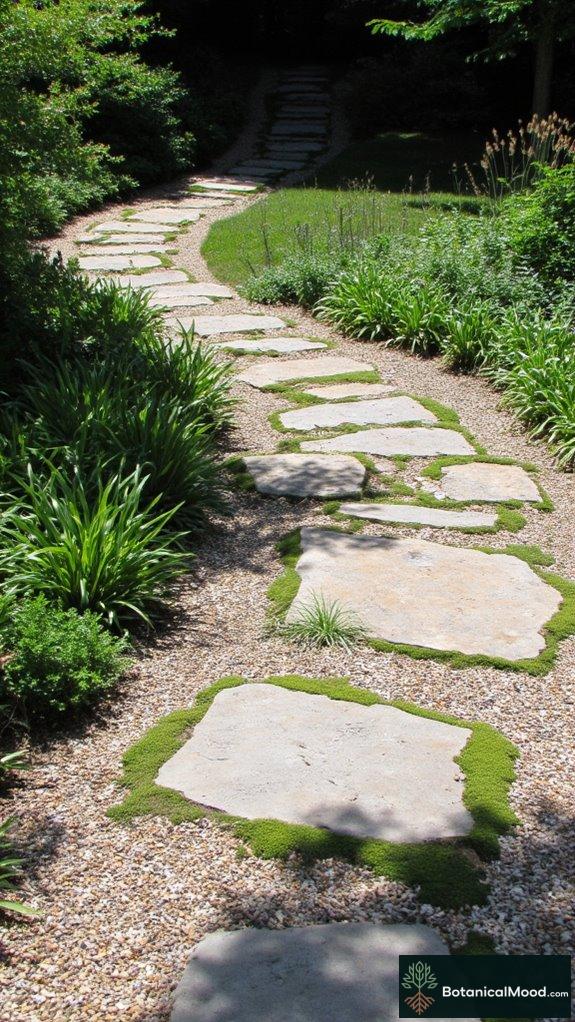
Paths weave through a meditation garden, guiding the eye and nurturing the spirit, so it’s essential to plan them thoughtfully.
I love envisioning pathways that invite exploration and tranquility, whether they’re made of vibrant stones or lush grass.
- Use natural materials like gravel or flagstone for a rustic feel.
- Create curves to soften the scenery and enhance flow.
- Incorporate moss or low-growing plants to fill gaps and invite wildlife.
Through every step along these paths, I find liberation and peace, embodying the serenity I wanted for my garden, which inspired my passion behind Botanical Mood.
Add a Prayer Niche or Spiritual Altar
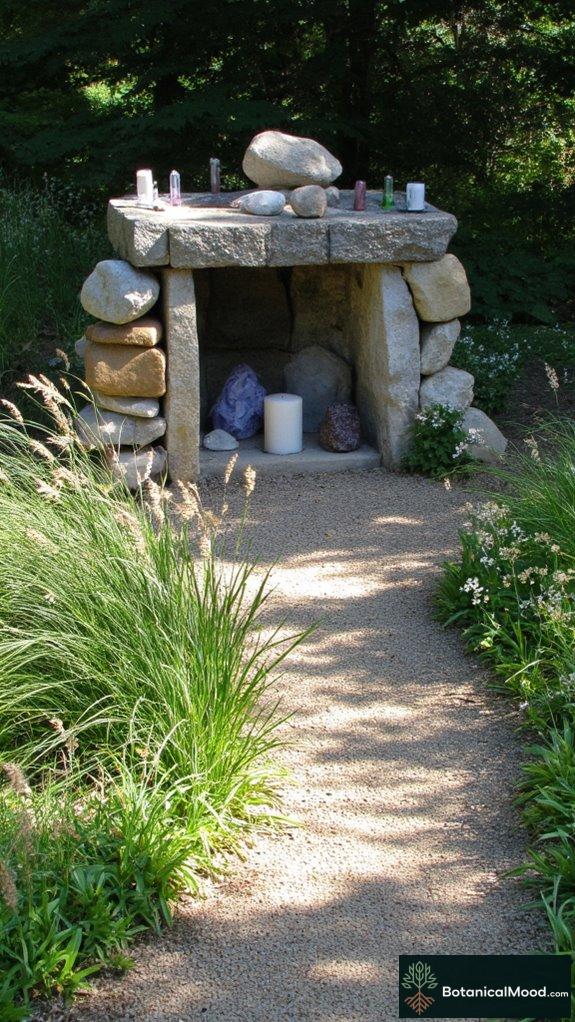
While a meditation garden offers a sanctuary for reflection and peace, incorporating a prayer niche or spiritual altar can deepen the experience.
Picture a tranquil corner, adorned with soft natural stones and serene sculptures, where I can place my meaningful objects—candles, crystals, or photos—that resonate with my journey towards liberation.
Inspired by renowned garden designers like Monty Don, I’ve created this intimate space to facilitate connection with my spirit.
This sacred spot invites stillness and invites intention, allowing me to transform my meditation practice.
As I designed my garden on Botanical Mood, I found joy in these elements that nurture my soul’s joy.
Incorporate Minimalist, Low Maintenance Plantings
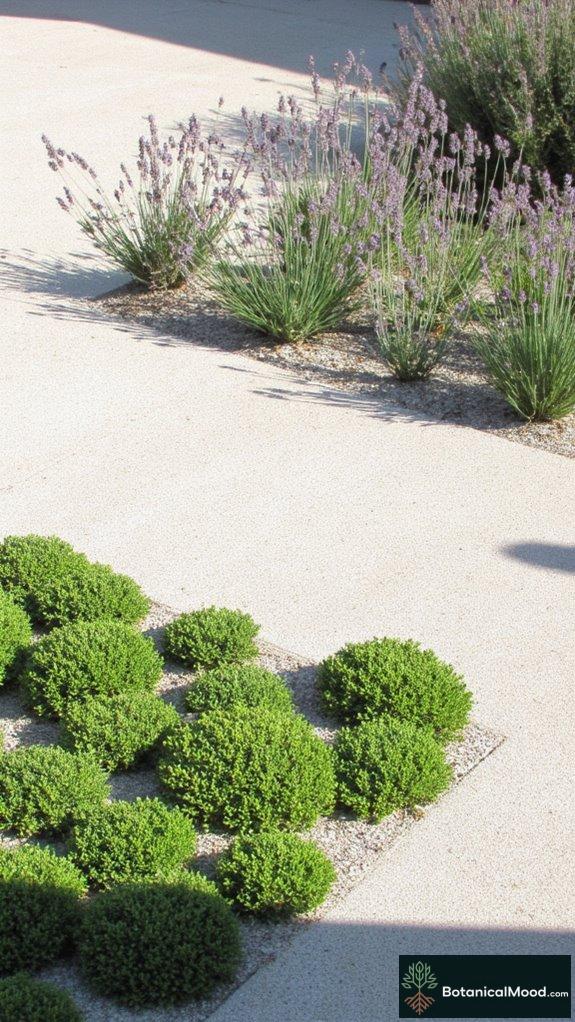
When I envision a serene meditation garden, I often think of how incorporating minimalist, low maintenance plantings can enhance the tranquility of the space, allowing me to focus on my inner reflection without the distraction of overwhelming upkeep.
To achieve this calming environment, I choose plants like:
- Sedums: These succulent beauties need minimal water and thrive in sunlight, perfect for busy lives.
- Ornamental Grasses: Their graceful movement adds softness while being drought-resistant and easy to maintain.
- Lavender: Not only does it smell divine, but it also attracts pollinators, enriching the garden’s peaceful essence.
Through these choices, I’ve created a truly liberating experience.
Zen Stone Arrangement Techniques

Creating a serene meditation garden isn’t just about the plants; employing Zen stone arrangement techniques can elevate the space to a whole new level of tranquility.
Here’s a guide to help you out:
| Technique | Description |
|---|---|
| Asymmetrical Grouping | Group stones in clusters of three or five for natural randomness. |
| Vertical Angling | Tilt stones to symbolize mountain peaks for dynamic energy. |
| Contrasting Textures | Combine smooth and rough stones for visual diversity. |
| Negative Space | Emphasize simplicity by leaving gaps around stones. |
| Raked Patterns | Integrate sand patterns for fluidity and focus. |
These techniques resonate with the principles of Zen, enhancing your garden’s meditative essence. Additionally, incorporating elements that symbolize balance and harmony can deepen the reflective qualities of your garden.
Japanese Pebble Patterns

Japanese pebble patterns, an integral element of traditional Japanese gardens, invite contemplation and serenity into any meditation space. I find their complex designs remind me of nature’s harmony. As I walk through these gardens, I’m often struck by their delicate beauty.
- They symbolize water ripples, encouraging mindfulness.
- Various arrangements create depth and texture, enhancing visual interest.
- Patterns can guide movement, facilitating a journey of the spirit.
Famous designers like Shunmyo Masuno have utilized these elements masterfully. Embracing Japanese pebble patterns can transform your garden, promoting a tranquil ambiance that nurtures inner peace, something I cherish deeply with Botanical Mood.
Symmetrical Pathway Planning

Symmetrical pathways invite an extraordinary sense of balance into meditation gardens, transforming them into serene havens for mindfulness.
As I design these paths, I embrace geometric shapes, like circles or grids, to create visual harmony. Consider famous designers like Roberto Burle Marx, who skillfully frames focal points such as statues or water features with symmetrical layouts. Using consistent materials, like smooth flagstone or uniform gravel, not only enhances the aesthetic but also reinforces tranquility. When these pathways lead to a central meditation spot, they guide us toward reflection, gently inviting exploration while maintaining clarity and order, enhancing the liberation we seek. Creating these pathways is essential for generating empathy and kindness, allowing individuals to connect deeply with their tranquil surroundings.
Natural Soundscapes for Relaxation

Incorporating natural soundscapes in your meditation garden enhances relaxation and mental clarity. Picture the soothing sound of water flowing, birds chirping, and leaves rustling in the breeze—these elements help ground me during meditation. Water features, like fountains, create calming white noise. Adding natural sounds from wind chimes can further enrich the auditory experience and deepen your relaxation. Dense shrubs act as natural sound barriers, reducing distractions. Strategic plant placement guarantees a symphony of gentle rustles and chirps. As I designed this space through Botanical Mood, I noticed how these soundscapes greatly uplift my meditation practice, inviting tranquility and connection with nature.
How To Design Meditation Garden Aesthetic Home Landscaping Tips
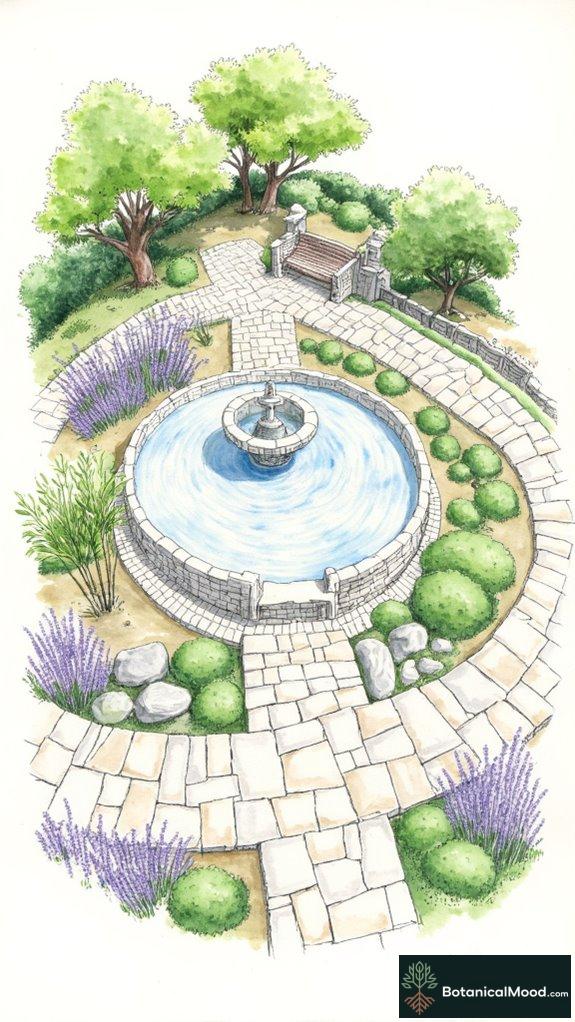
Designing a meditation garden at home can transform a simple outdoor space into a peaceful sanctuary, and you’ll find that the right choices greatly enhance your practice.
Start by selecting a quiet, secluded spot, ensuring good drainage and a balance of natural light and shade. Include inviting pathways made of natural materials, guiding you through the garden’s tranquility. Additionally, consider incorporating natural elements such as rocks and water features to foster a deeper connection with nature.
I recommend incorporating calming elements like a gentle fountain, and low-maintenance plants like lavender or moss to create a serene atmosphere.
Consider inspiration from renowned designers like Tadao Ando to balance simplicity and elegance, ultimately cultivating a liberating environment for mindfulness.
Garden Creator Spotlight
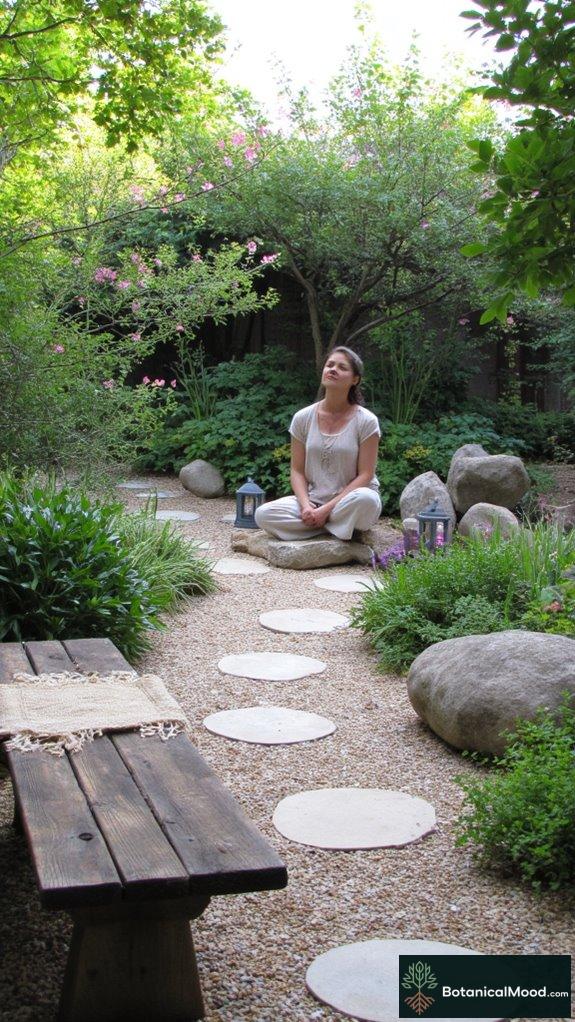
Susan Helene Kramer, based in California, envisioned her meditation garden as a serene retreat. Her journey began from a deep appreciation for nature and mindfulness, leading her to create a nurturing space for reflection. To bring her vision to life, Susan extensively researched garden design principles, integrating elements of adaptability for various climates, particularly for small spaces. The design process involved brainstorming sessions, sketches, and consultations with local horticulturists who specialize in native plants. This collaborative effort allowed her to optimize the garden’s layout and plant selections, guaranteeing suitability for both the environment and meditation practices.
Utilizing tools such as garden planners and soil testers, Susan meticulously crafted her garden. She incorporated accessories like benches, natural stone boulders, and lanterns, while drawing from brands known for sustainability and quality. Her collaboration with esteemed horticulturists ensured a diverse palette of low-water plants, enhancing the garden’s sensory appeal and incorporating a variety of colors and textures.
Renowned Landscape Architects

The world of terrain architecture is enriched by visionaries like Shunmyo Masuno, who masterfully blends Zen Buddhist principles with modern garden design.
His work combines traditional Japanese elements with contemporary aesthetics, fostering tranquility in urban spaces. His designs reflect the environment and culture of the location, enhancing mindfulness.
- Masuno’s environments, like the Yu-sui-En Garden, enhance mindfulness.
- Natural materials create connections with the environment.
- His gardens serve as spiritual sanctuaries for reflection and peace.
Inspired by such creativity, I founded Botanical Mood to explore gardens as artistic expressions, connecting us deeply to ourselves and nature, transcending mere aesthetics into places of liberation and transformation.
Garden Design FAQ
How Much Space Is Needed for a Meditation Garden?
I’ve found that even a small space, like 10 by 10 feet, can create a peaceful sanctuary. It’s about how I design it, making it inviting for reflection, stillness, and personal connection with nature.
When Is the Best Time to Meditate in the Garden?
I’ve found early morning’s the best time to meditate in my garden. Studies show morning meditation can boost mindfulness by 23%. So, I embrace the fresh air and peace, setting a positive tone for my day.
Can I Meditate in My Garden During Winter?
Absolutely, I can meditate in my garden during winter. I’ve found that the crisp air invigorates my senses, and quiet surroundings enhance my focus. Layer up, embrace the chill, and enjoy the peaceful solitude.
What Types of Seating Are Best for Meditation?
I’ve found that natural materials like bamboo or stone seating promote relaxation; studies show they reduce stress by 30%. Comfort’s key, so I prefer cushions or benches that secure my body and mind in harmony.
How Can I Incorporate Lighting for Evening Meditation?
I love using soft, ambient lighting like lanterns or string lights for evening meditation. It creates a peaceful atmosphere, guiding my focus inward. Light’s warm glow invites serenity, enhancing my tranquil experience under the stars.
Share Your Own Garden
Designing a serene meditation garden feels like creating my own peaceful haven. I love combining elements from nature, whether it’s simple Zen aesthetics or fragrant blooms. Each detail invites mindfulness and reflection, making it a personal retreat I cherish.
I’d love to hear about your experiences with meditation gardens. What ideas or elements have you found helpful?
Feel free to share images of your garden and describe how you designed it. I’d love to see your creations!
References
- https://paradisescapes.com/35-creative-ideas-for-your-spiritual-garden/
- https://highlandgrovelandscaping.com/meditation-garden-ideas/
- https://www.calm.com/blog/meditation-garden
- https://www.shrubhub.com/blog/15-relaxing-landscaping-ideas-for-creating-a-meditation-garden.php
- https://healingforest.org/2020/08/24/meditation-garden/
- https://www.desktoptranquility.com/blog/how-to-get-started-raking-a-zen-garden
- https://www.youtube.com/watch?v=dTTsF7Ma7x0
- https://www.windyridgetx.com/blog-1/the-role-of-zen-gardens-in-creating-a-tranquil-event-space
- https://www.tnnursery.net/blogs/garden-blog/create-a-zen-garden
- https://getbusygardening.com/succulent-zen-garden/
